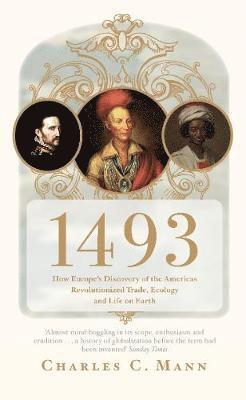
- Format
- Häftad (Paperback / softback)
- Språk
- Engelska
- Antal sidor
- 720
- Utgivningsdatum
- 2012-09-06
- Förlag
- Granta Books
- Illustrationer
- Illustrations, maps, ports.
- Dimensioner
- 197 x 132 x 50 mm
- Vikt
- Antal komponenter
- 1
- ISBN
- 9781847082459
- 480 g
1493
How Europe's Discovery of the Americas Revolutionized Trade, Ecology and Life on Earth
- Skickas från oss inom 2-5 vardagar.
- Fri frakt över 249 kr för privatkunder i Sverige.
Passar bra ihop
De som köpt den här boken har ofta också köpt DK Eyewitness Switzerland av Dk Eyewitness (häftad).
Köp båda 2 för 319 krKundrecensioner
Fler böcker av Charles C Mann
-
1491 (second Edition)
Charles C Mann
-
1491
Charles C Mann
-
Wizard And The Prophet
Charles C Mann
-
The Wizard and the Prophet
Charles C Mann
Recensioner i media
A "New York Times" Notable Book A "TIME" Magazine Best Book of the Year A "Washington Post "Notable Book "Fascinating. . . . Lively. . . . A convincing explanation of why our world is the way it is." --"The New York Times Book Review" "Even the wisest readers will find many surprises here. . . . Like "1491," Mann's sequel will change worldviews." --"San Francisco Chronicle" "Exemplary in its union of meaningful fact with good storytelling, "1493" ranges across continents and centuries to explain how the world we inhabit came to be." --"The Washington Post " "Engaging . . . Mann deftly illuminates contradictions on a human scale: the blind violence and terror at Jamestown, the cruel exploitation of labor in the silver mines of Bolivia, the awe felt by Europeans upon first seeing a rubber ball bounce." --"The New Yorker" "Revelatory." --Lev Grossman, "Time" Magazine "Compelling and eye-opening." --"Publishers Weekly" Top 100 Books of 2011 "A book to celebrate. . . A bracingly persuasive counternarrative to the prevailing mythology about the historical significance of the 'discovery' of America. . . "1493" is rich in detail, analytically expansive and impossible to summarize. . . [Mann's book] deserves a prominent place among that very rare class of books that can make a difference in how we see the world, although it is neither a polemic nor a work of advocacy. Thoughtful, learned and respectful of its subject matter, "1493" is a splendid achievement." --"The Oregonian" "Despite his scope, Mann remains grounded in fascinating details. . . . Such technical insights enhance a very human story, told in lively and accessible prose." --"Cleveland Plain-Dealer " "Mann's excitement never flags as he tells his breathtaking story. . . There is grandeur in this view of the past that looks afresh at the different parts of the world and the parts each played in shaping
Övrig information
Charles Mann is the co-author of four books, including The Second Creation: Makers of the Revolution in 20th Century Physics and the bestselling 1491 (2005/6). He is the correspondent for The Atlantic Monthly and Science magazines, and editorial co-ordinator for the internationally best-selling Material World books. He lives in Massachusetts.


